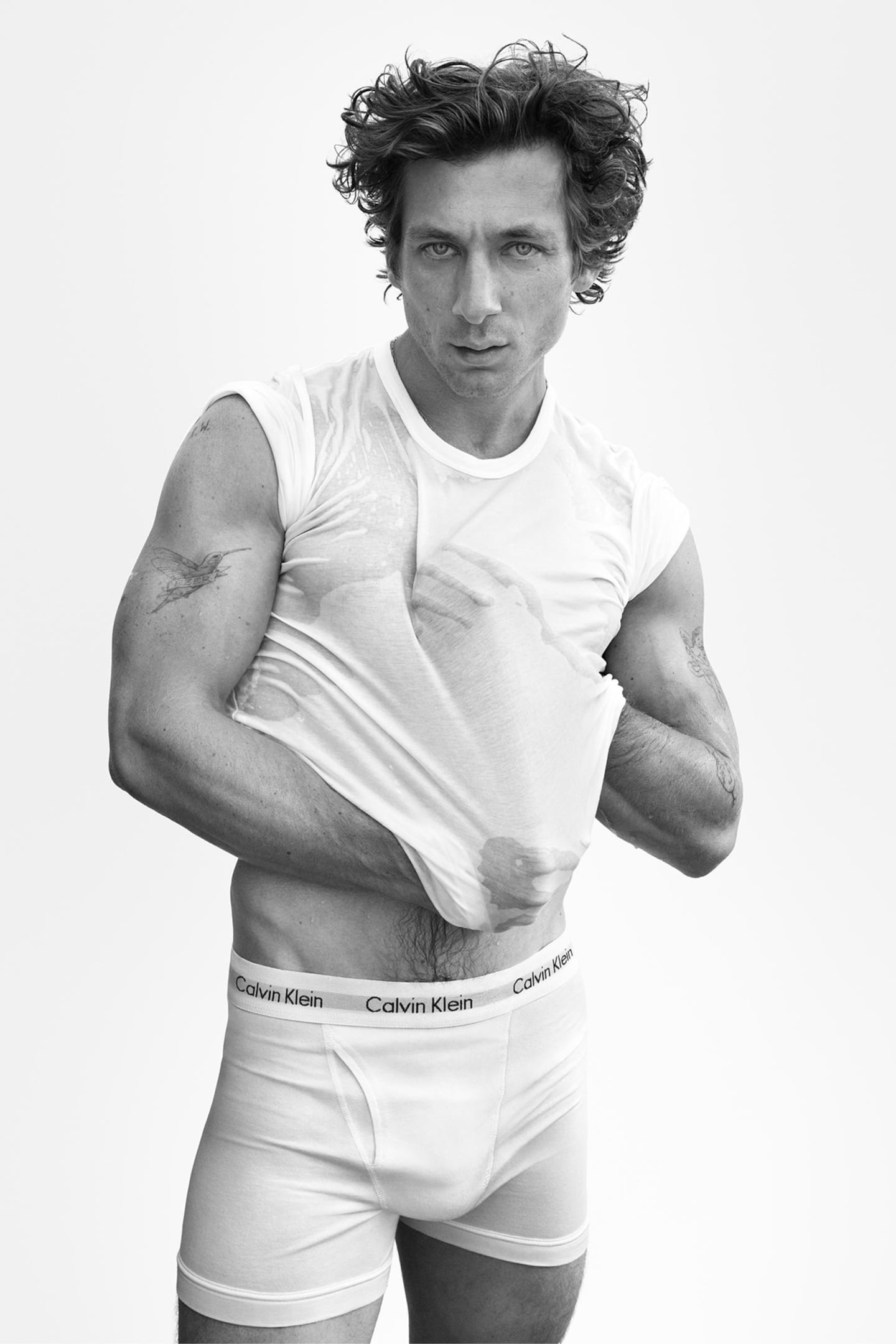
The Business of Fashion
Agenda-setting intelligence, analysis and advice for the global fashion community.

Agenda-setting intelligence, analysis and advice for the global fashion community.

Just a few days into 2024, Jeremy Allen White’s bare, muscled body — clad in Calvin Klein briefs — became the year’s first viral sensation.
The brand unveiled the ads on Jan. 4, instantly prompting a swell of online chatter. It only intensified after the images of White were plastered on Calvin Klein’s iconic billboard on Houston Street in the centre of New York’s SoHo neighbourhood, and the brand released a video ending with a dozen doves bursting into the sky alongside White spread on a couch, wearing nothing but his cotton stretch briefs and sneakers.
The ad was classic Calvin Klein, which has been synonymous with sexy, conversation-starting campaigns since the 1970s. In just 48 hours, the White ads generated $12.7 million in media impact value, data insights company Launchmetrics’ proprietary measure of engagement. For comparison, Bottega Veneta’s Pre-Spring 2024 campaign featuring paparazzi shots of Kendall Jenner and A$AP Rocky generated $2.8 million in 48 hours, said Launchmetrics.
The White ads were just the start of the headlines for Calvin Klein this year. On Jan. 10, the UK’s Advertising Standards Authority banned a Calvin Klein ad starring a similarly-scantily clad musician FKA Twigs, stating that the images focused on FKA Twigs’ “physical features rather than the clothing, to the extent that it presented her as a stereotypical sexual object.”
ADVERTISEMENT
The decision quickly drew backlash, with critics decrying the agency for policing female sexuality and a woman’s body. The ongoing praise for White’s ads — which were not banned — provided a stark contrast. So did the fact that the agency said images of Kendall Jenner from the same campaign were “unlikely to be seen as irresponsible,” which elicited charges of racism.
“I do not see the ‘stereotypical sexual object’ that they have labelled me,” FKA Twigs said on Instagram. In a response to the ban, Calvin Klein said it had put out similar advertisements in the UK for decades and “a degree of nudity should be expected” in underwear advertising.
Calvin Klein has a long history of leaning on provocation to sell its mass market staples. Its ads have featured a topless Kate Moss, an underage Brooke Shields uttering innuendos and Mark Wahlberg grabbing himself. A 2008 perfume ad starring Eva Mendes was banned in the US. But over the past decade, Calvin Klein’s ads have mostly failed to attract the same level of attention, primarily putting out lacklustre group campaigns that were lost in the churn of social media.
The industry, too, has gotten more cautious with advertising. In the face of slumping sales, Victoria’s Secret shed its ultra-sexy image, while missteps from brands like Balenciaga and Zara have shown the danger of a poorly-received campaign.
But as Calvin Klein’s recent brush with virality shows, the right sort of provocation can pay dividends for a brand’s image.
“Brands can’t cancel-proof or bubble wrap their way through life. In this TikTok era, you need to make moments,” said Matt Kissane, executive director at marketing agency Landor.
At their best, Calvin Klein’s ads have solidified stars as sex symbols. They played a major role in positioning Moss as the queen of heroin chic in the 1990s, and helped Wahlberg move beyond his “Marky Mark” era. Justin Bieber’s campaign in 2015 cemented him as someone for adults to lust after (rumours of a photoshopped bulge notwithstanding) rather than a teenage Tiger Beat pin-up. This latest campaign seems poised to do the same for White.
What the formula ultimately comes down to is picking the right face at the right time.
ADVERTISEMENT
White’s star has been on the rise, thanks to his role as an endearing dirtbag chef on the Hulu series “The Bear.” His street style makes regular appearances in men’s magazines GQ and Esquire, and he’s regularly papped sweaty and shirtless in Los Angeles. Rumours of a relationship with popstar Rosalía, and his latest starring turn in wrestling film “The Ironclaw,” add to the intrigue.
Also, abs.
“Just human instinct, this is a hot campaign,” said Amy Kommatas, head of production for advertising firm Callen. “It got people talking. America is thirsty.”
Where many fashion brands are stuck in a bit of a casting rut — hiring a Jenner or Hadid for the inevitable press that follows — this marks White’s first major campaign, creating a sense of newness at a time when constant noise on social media makes it even harder for brands to stand out.
“It was one thing to break out 30 years ago, you could spend enough money to push it out. It’s 100 percent harder now because there’s so much content, so many more eyeballs,” said Allen Adamson, founder of marketing firm Metaforce.
Calvin Klein promoted the campaign from all angles. Besides the billboard, videos and Mert Alas-lensed images pushed across social media, the brand also dressed White for the Golden Globes (where he won the trophy for best actor in a television series, drama) and secured an accompanying Vogue feature on the “formal” Calvin Klein underwear White wore under his suit.
Over the course of the campaign, mentions of Calvin Klein skyrocketed 567 percent higher than average and the brand gained 100,000 followers on TikTok, according to data intelligence firm Brandwatch.
While the formula may seem simple, pulling it off requires more than a bit of luck.
ADVERTISEMENT
“For every time somebody gets it right, 20 people get it wrong, and they’re all using the same formula,” said Adamson.
The FKA Twigs ad brought the brand a different sort of attention, going viral only after the images were banned.
Calvin Klein has long toed the line of public acceptability, and critics have slammed the brands’ ads as promoting everything from an unhealthy body image and drug use with Moss, to even alleging child pornography with a 1995 campaign that showed young models in a wood-panelled basement. (The US Justice Department ended up investigating the campaign, which was pulled, though the brand was able to prove that all models featured were adults.)
Meanwhile, no one besides the ASA seems to be admonishing Calvin Klein over the FKA Twigs ads. In fact, the ban has helped build positive sentiment around the images, where they may have gone less-noticed otherwise. The FKA Twigs image has already created $5.2 million in MIV for Calvin Klein.
As society at large teeters toward conservatism — with women’s rights under attack, particularly in the US — the images ended up prompting conversation around why a man can show his body (not to mention, earn money and status, said Kissane) and a woman is shamed for the same thing.
“It’s disappointing that we’re at this place in our culture where Jeremy Allen White is celebrated, but FKA [Twigs] is policed,” said Kommatas.
For Calvin Klein, both sets of ads are an example of that old adage — there’s no such thing as bad publicity.
“They’ve managed to create the cultural conversation,” said Kissane. “It set the wheels in motion. [Calvin Klein] played its one move and the wheels of the internet are doing the turning.”
As seen in its latest collaboration with skate brand Palace, Calvin Klein’s path forward is focused on highlighting its most successful categories like denim and underwear.
The American sportswear brand best known for its logo-stamped underwear allowed the comedian apparent access to its Instagram account.
Even amid financial pressure, in 2024, marketers should focus on the strength of their brand, not the number of clicks on their Instagram ads.

Joan Kennedy is Editorial Associate at The Business of Fashion. She is based in New York and covers beauty and marketing.
Often left out of the picture in a youth-obsessed industry, selling to Gen-X and Baby Boomer shoppers is more important than ever as their economic power grows.
This month, BoF Careers provides essential sector insights to help PR & communications professionals decode fashion’s creative landscape.
The brand’s scaled-back Revolve Festival points to a new direction in its signature influencer marketing approach.
Brands selling synthetic stones should make their provenance clear in marketing, according to the UK’s Advertising Standards Authority.